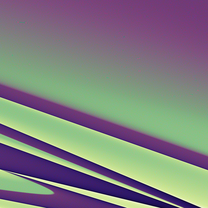


Although I liked the Faux Amplituhedron, I was curious to see what Chatgpt would come up with if I’d tell it to replace the placeholder polygon with “a true evaluation of your amplituhedron canonical form.” It did not disappoint.
(Please note that this doesn’t mean the resulting image is scientifically meaningful. If anything, it’s a science-inspired code/art experiment.)
import numpy as np from PIL import Image from hilbertcurve.hilbertcurve import HilbertCurve # 1) Grid size W = H = 4096 N = W * H # 16,777,216 # 2) Camera parameters (pan and zoom) to frame the amplituhedron # center_u, center_v specify the focal point in the unit square # zoom >1 zooms in, <1 zooms out center_u, center_v = 0.5, 0.3 zoom = 1.5 half_range = 0.5 / zoom u_min, u_max = center_u - half_range, center_u + half_range v_min, v_max = center_v - half_range, center_v + half_range # 3) Build cyclic polygon data for A(n,1,2) on the moment curve def build_amplituhedron_data(n=8): """ Build cyclic polygon data on the planar moment curve for A(n,1,2). Returns Z (n×3 array) and precomputed triangle volumes and cross-products. """ t = np.linspace(0.1, 0.9, n) Z = np.vstack([np.ones(n), t, t**2]).T Z0 = Z.mean(axis=0) tri_volume, cross_12, cross_20, cross_01 = [], [], [], [] for i in range(n - 1): A, B = Z[i], Z[i+1] tri_volume.append(np.linalg.det(np.stack([Z0, A, B], axis=1))) cross_12.append(np.cross(A, B)) cross_20.append(np.cross(B, Z0)) cross_01.append(np.cross(Z0, A)) return Z, Z0, np.array(tri_volume, float), cross_12, cross_20, cross_01 Z, Z0, tri_volume, cross_12, cross_20, cross_01 = build_amplituhedron_data(n=8) # 4) Define the true amplituhedron canonical-form evaluator def amplituhedron_value(u, v, epsilon=1e-12): """ Evaluate the canonical-form density F(u,v) of A(n,1,2) at Y=(u,v,1). Regularizes exact boundary poles by epsilon. """ Uy = u.ravel(); Vy = v.ravel() pts = np.column_stack([Uy, Vy, np.ones_like(Uy)]) F_flat = np.zeros_like(Uy, float) for i in range(len(tri_volume)): d1 = pts.dot(cross_12[i]) d2 = pts.dot(cross_20[i]) d3 = pts.dot(cross_01[i]) F_flat += tri_volume[i] / (d1 * d2 * d3 + epsilon) return F_flat.reshape(u.shape) # 5) Sample the field with camera framing and rank pixels us = np.linspace(u_min, u_max, W) vs = np.linspace(v_min, v_max, H) U, V = np.meshgrid(us, vs) F = amplituhedron_value(U, V).ravel() pixel_order = np.argsort(-F, kind='mergesort') # 6) Generate full 24-bit palette and sort by a 3D Hilbert curve for smooth color continuity colors = np.empty((256**3, 3), dtype=np.uint8) idxs = np.arange(256**3, dtype=np.uint32) colors[:,0] = (idxs >> 16) & 0xFF colors[:,1] = (idxs >> 8) & 0xFF colors[:,2] = idxs & 0xFF # Build 3D Hilbert indexer on 8-bit coordinates hc3 = HilbertCurve(p=8, n=3) # Coordinates for each color coords_rgb = np.column_stack([colors[:,0], colors[:,1], colors[:,2]]) # Compute Hilbert distances (slow but one-time) distances = np.array(hc3.distances_from_points(coords_rgb.tolist()), dtype=np.uint32) color_order = np.argsort(distances, kind='mergesort') # 7) Assemble image and save img_flat = np.empty((N,3), np.uint8) img_flat[pixel_order] = colors[color_order] img = img_flat.reshape((H, W, 3)) Image.fromarray(img).save('amplituhedron_true_unique_palette_hilbert.png') print("Saved: amplituhedron_true_unique_palette_hilbert.png")
| Date | |
|---|---|
| Colors | 16,777,216 |
| Pixels | 16,777,216 |
| Dimensions | 4,096 × 4,096 |
| Bytes | 49,219,530 |
